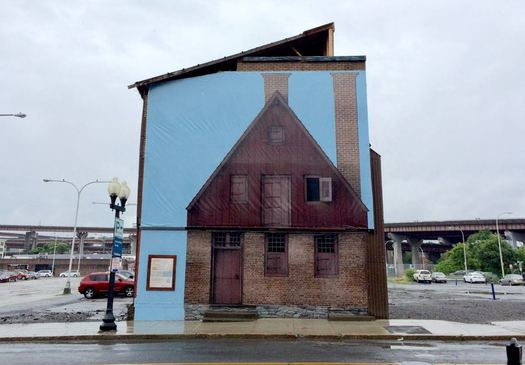Albany's oldest building has a new face

The Van Ostrande-Radliff House at 48 Hudson Avenue in downtown Albany -- which dates back to 1728 -- now has a scrim that depicts how it might have looked back in the long ago day. The new look is part of an effort by the Historic Albany Foundation, which owns the building, to raise money for its preservation and renovation. Blurbage:
Installed on the north side of the building is a large, durable fabric scrim depicting in real size what 48 Hudson Avenue might have looked like at the time of its construction ca. 1728, showing features typical of an urban Dutch dwelling. The rendering is based on research from the historical record conducted by Dr. Charles Gehring and Dr. Janny Venema of the New Netherland Research Center about contemporary houses in Dutch Albany, the Netherlands, and New Netherland, of which Albany was a part from 1614 to 1664, when control of the region was transferred to the English. The building is an example of the persistence of Dutch culture in the Hudson Valley long after the close of the Dutch period, and is a rare link to this foundational period in American history.
Money for the scrim came via the Dutch consulate, as part of an effort to promote Dutch arts and culture in the United States.
Historic Albany figures the whole project preserve and restore 48 Hudson will cost $2 million. It got a grant last year from the state Office of Parks, Recreation and Historic Preservation for $268k for the first phase. It needs to raise about $89k as part of its match for the money -- and it's collecting donations online.
Hi there. Comments have been closed for this item. Still have something to say? Contact us.
Comments
All well and good that someone managed to con the Dutch into giving money to this bamboozle, but nothing in this article answers a basic question: to what end? In case no one else has noticed, this structure is all alone in the middle of a wasteland with vacant lots on three sides and a parking garage facing it on the fourth. Will it become more tax-exempt land that the tax payers of the city will be burdened with supporting? Almost certainly. Will it (just as likely) languish in its present state for years as fuzzy-headed activists solicit for ever more money to "finish" the project? One thing I can say for certain: it will serve no useful purpose in the life of this city. It will employ no one. It will feed no one. It should have been allowed to burn or collapse, and pass into history honorably.
... said MICHAEL STIMAC on Jun 19, 2017 at 5:55 PM | link
Having been inside this building, it is an amazing piece of history and architecture; the building tells the story. Yes, the landscape is a bleak but there are signs of life. On one side are restored historic buildings with restaurants, lofts and businesses and a small park. Within a block are the TU center, path to riverside park, and all kinds of cool architecture. Yes, I'd like to see the city move faster on enabling redevelopment in this section too and get more on the tax rolls, but bravo to all who are active in making this block better! Thank you HAF (& artists) for this little gem.
... said JulieA on Jun 20, 2017 at 8:44 AM | link